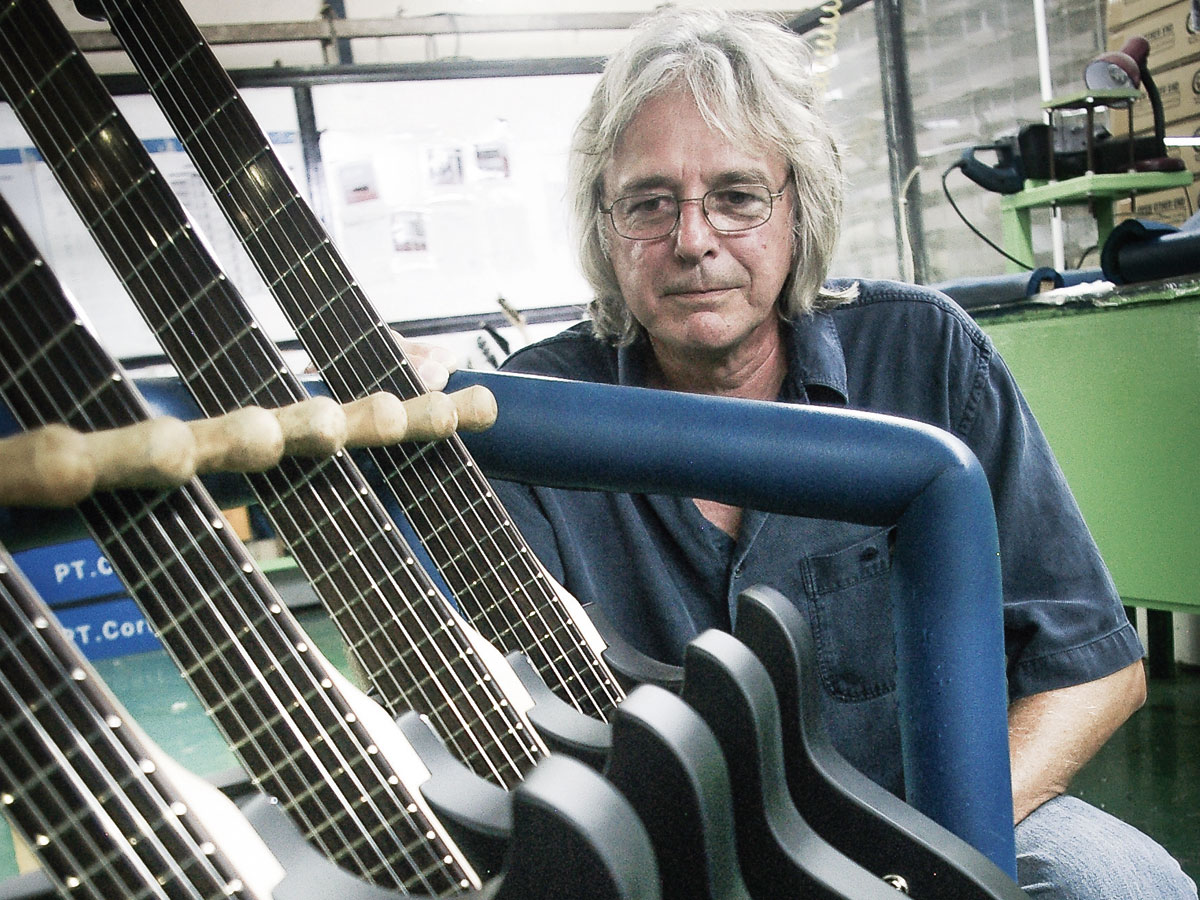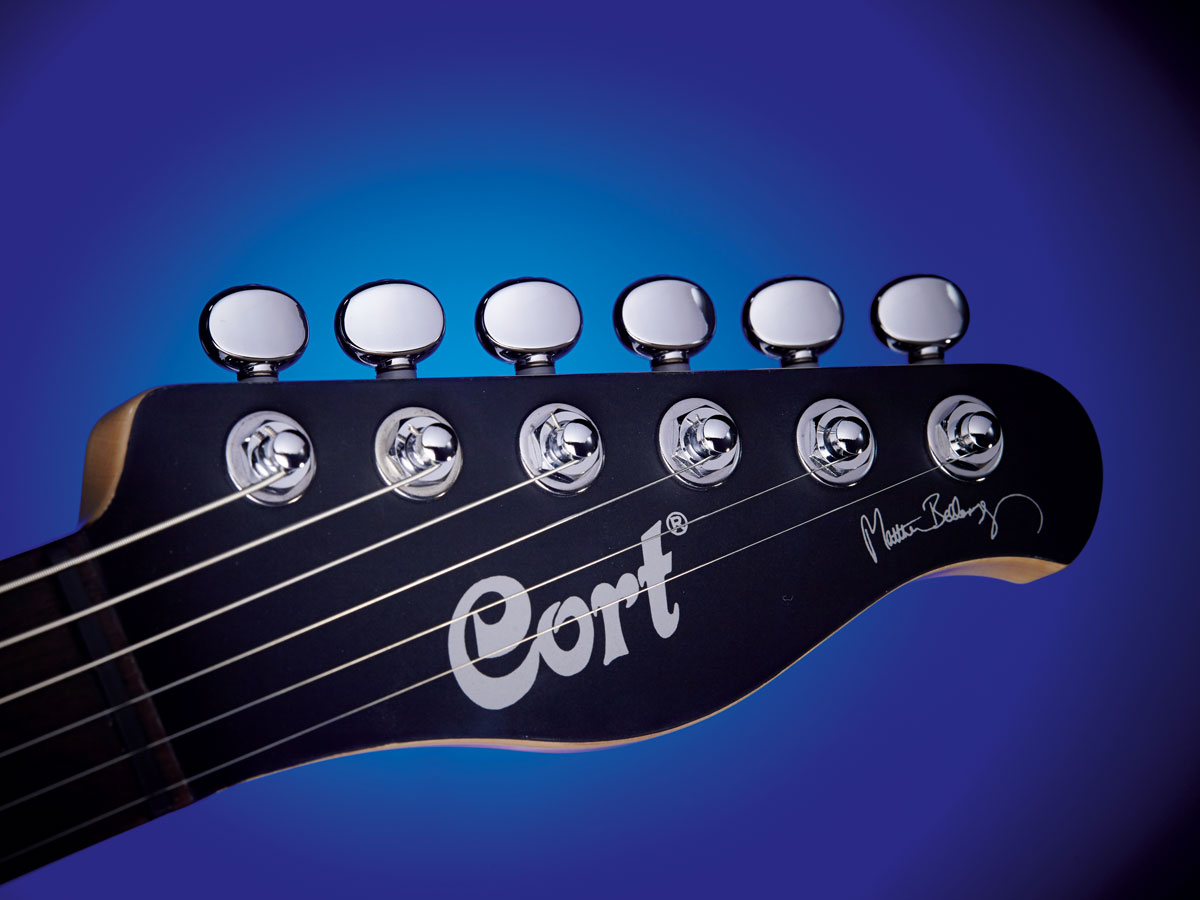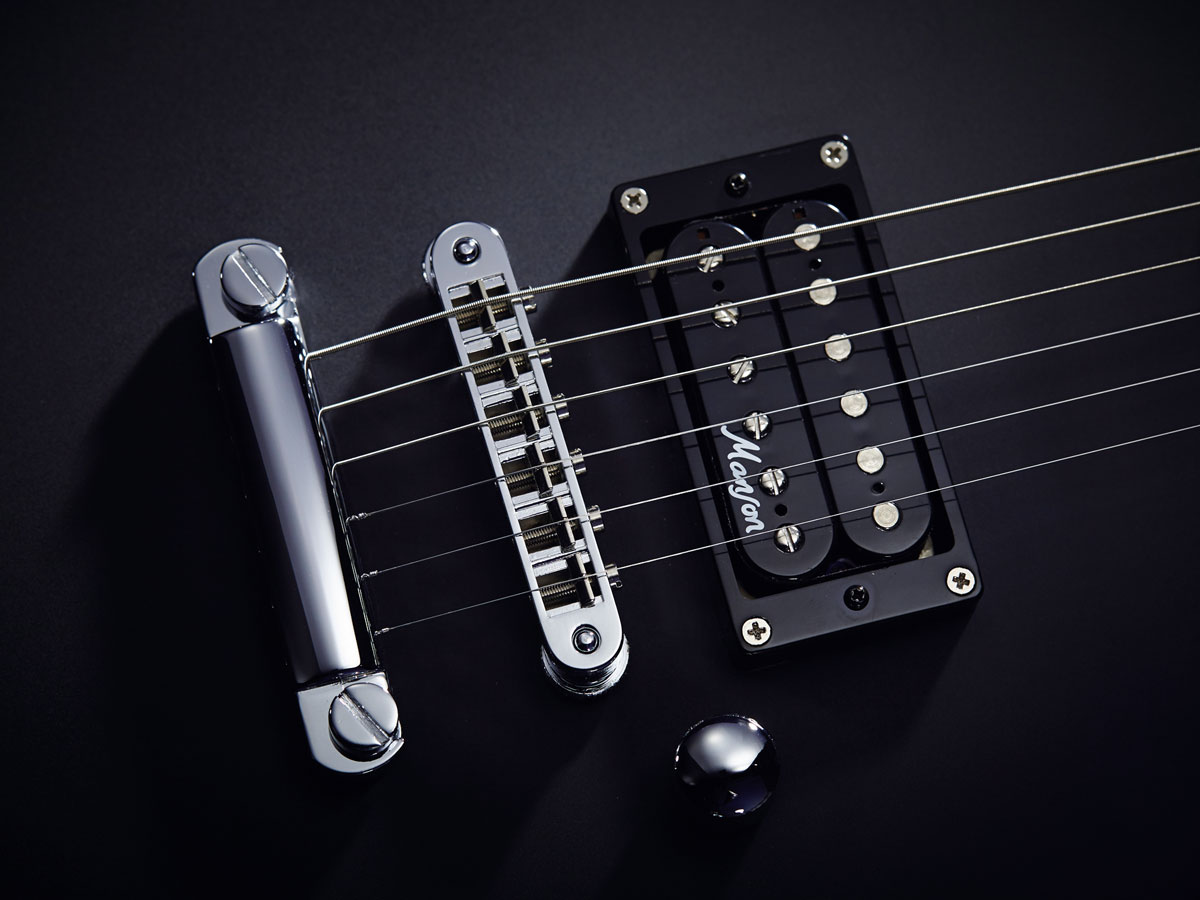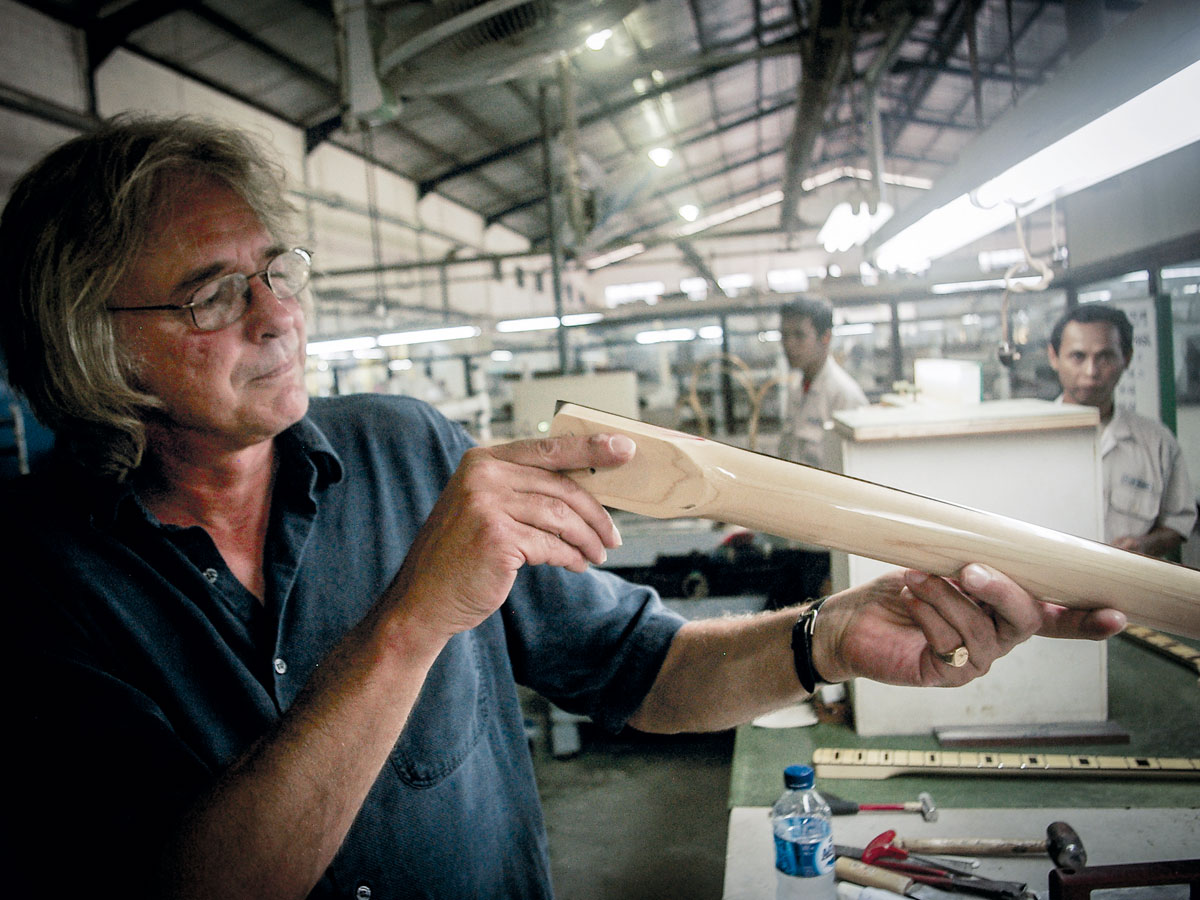Hugh Manson discusses the Cort MBC-1 Matt Bellamy
Designing the Muse-man's signature guitar

Introduction
An official Matt Bellamy signature model has been a long time coming for Muse fans on a budget, but finally, the wait is over as the MBC-1, a joint venture between Manson, Cort and Bellamy himself, has arrived.
The result of three years’ design, development and prototyping, the whole thing was overseen by pioneering UK guitar builder (and maker of pretty much every guitar Matt plays) Hugh Manson.
Naturally, when we found out about the MBC-1, we wanted to know all about it, so we caught up with Hugh to bring you the full story behind one of the most anticipated signature guitars of the last decade.
How did your relationship with Matt Bellamy begin?
“Matt was a customer of Mansons Guitar Shop when it first opened. When he got his first advance for the first album, he came in and obviously knew I was a guitar maker - and ordered his first guitar.
"It was the aluminium-clad guitar that’s commonly known as the DeLorean, that was the first guitar. Since then he’s had something like 28 guitars, all different with different features.”

Finding his Muse
Were you aware of Muse in the early days?
“Well, they played their first gig in the basement of our local pub, so we were aware of them. They were at college together, and we helped them out a lot in the early days.
"There are many guitar makers building re-hashes, and I try to make things that are radically different"
"We were the importers for Matchless and Soldano, so we helped them out with amps, Dennis at Sawmills studio was their manager, and we had a close relationship with him. So it all fell into place beautifully, it was fortunate we were local.”
You’ve produced some ambitious designs over the years, is this a challenge?
“Matt’s great to work with because the most exciting kind of musician to work for as a guitar maker is a person who knows what they want to achieve, but have no idea how to achieve it.
"I work similarly with other artists who have a great vision of sonically what they want to achieve, but have no idea of how a guitar is made, or what they’re made of and why, and what woods produce different sounds. It makes it reasonably creative from my point of view.
"There are many guitar makers building re-hashes, and I try to make things that are radically different, so when you get asked to make them it’s great, because it gives you the excuse to do it! Particularly finishes, you know? It’s great to find someone who’s willing to experiment. Fortunately, he’s got pretty great stage presence, too, so I can make guitars that look pretty wild onstage instead of just a Three-tone Sunburst!”

Shaping up
Where does the MB shape come from?
“Well the shape - he hasn’t quite stuck with it. The DeLorean was the first, that had an enormous top horn on it, and we’ve gradually made it smaller over the years, more pleasant to the eye, really.
"We decided years ago that a more affordable model would be a good idea"
"We kind of designed it together. I did the drawing, then Matt turned up and said, ‘Oh make that bit bigger, make this a bit smaller...’ and we added all the bits. I’ve still got the original drawing.”
When did the idea for an affordable version of Matt’s guitar come about?
“Well, it started before any of our licensed guitars came out, I was getting requests every day: ‘Can you build me the same as what Matt Bellamy plays?’, and I wouldn’t do it because I’ve been honourable to Matt. It’s the guitar he’s known for and I didn’t want everybody else to have them.
"So we started negotiations and finally came up with the MB Series - the black one and the red glitter one - but they’re over £3,000. They’re very labour-intensive, they take a long time to make and we can only make a particular number.
"Now, because the Muse fanbase is so enormous, we decided years ago that a more affordable model would be a good idea. It would make all the fans happy and we could produce a good guitar for a good price.”

Hitting the big time
How did you settle on Cort for the MBC-1?
“It went on and on and on, we offered it to many other companies and got turned down by pretty much every major guitar company. So I took the bull by the horns and decided to go and find a manufacturer who wanted to make this.
"I went to the Cort factory and was completely blown away by the attention to detail"
"So I found Cort, and my mental process was ‘Let’s pick the biggest guitar manufacturer in the world’ on the basis that repetition would prove perfection. If you make a million guitars a year, you’re gonna get pretty good at it.
"I went to the factory and was completely blown away by the attention to detail. At every single production stage there’s unbelievable checking processes. I was just so impressed. The pickup manufacturing is state-of-the-art, and they were really keen to listen to my outlook on making guitars. So it was win-win all around.”
Did it take a long time to arrive at the final version of the guitar?
“The development, from choosing the company to getting a prototype in my hands, was maybe two to three years. We went through every single thing, from the weight of the body wood, the shape of the neck, the compound radius of the fingerboard, the size of the frets.
"The pickups; that was a really long one. We’d send them pickups that we’d made here, they’d send us pickups that they’d made, god knows how many different types of magnets and slug sizes! We had necks and pickups flying backwards and forwards for ages. It just went on and on!”

Putting your neck on the line
So this is far from just a production guitar with a famous name on the headstock?
“We spent a long time working on the neck, particularly the truss rod. I didn’t want the typical aluminium and steel bar in there, because the neck is completely crucial to the way the string vibrates and resonates and sustains.
"If you make a neck out of the most lovely piece of maple, then get a bloody-great 10mm router bit and route out a 10 by 10 slot, then fill it with a piece of aluminium and steel which is 40 per cent air, you’re destroying any potential for resonance.
"Every prototype, he got to see and play. His input was really good about the finish, and the pickups, every aspect"
"The truss rod adjuster - I’m a tech and I’ve tech’d on the road for years - to take the neck off to adjust the truss rod is not ideal, so that’s why the thumbwheel adjuster is at the bottom of the neck. You can just put a bar in there and turn it real quick.
"One thing I was worried about was not having dots on the fingerboard, but do you really ever look at the front of the fingerboard when you’re playing? You look at the side. You might look at the other guy’s to find out what key you’re supposed to be in! So we went with no dots. It’s got side-markers, you’d be snookered without those!”
Was Matt involved at every stage?
“Oh yeah, totally. Every prototype, he got to see and play. His input was really good about the finish, and the pickups, every aspect. But I’m a guitar-maker, he’s a musician, so I’d interpret his comments into guitar making terminology to give to Cort, so it was quite challenging.”
What about the matt black finish?
“The finish was a whole other thing. The trouble with matt black finishes is that, if you hang them up in a shop and 10 people play it, before the 11th person buys it, they’re probably going to buy it as a second-hand guitar because matt finishes mark very easily.
"So we spent ages researching matt finishes, and came up with a firm in Holland who make the perfect finish, which has a completely different application to guitars. If you get a pick and try and scratch the front of it, you’ll find it’s extremely difficult to do! I’m very proud of that finish.”

An open guitar
It also features a kill button...
“Fitting a kill button is a very easy piece of wiring, it just shorts the live signal to earth, it’s quite basic. We couldn’t put the effects in it because it would have put the price up too high, so a kill button is a very economical way of producing an effect without shoving another £500 on the price.”
Is there likely to be a retro-fit option for some of the effects?
“I think we’re looking into that, and the custom hardware; the round machineheads and aluminium knobs. We’re a bit concerned about quantities on that, but we’ll cross that bridge when we come to it.
"I don’t want it to be limited to Muse fans. It’s a perfectly open guitar for anybody, you can play whatever you want on it"
"I’m sure a lot of people will want to put the Fuzz Factory and the Sustainer in it, I’m not sure the screen will fit because of the bridge. This guitar would suit the Sustainer because of the positioning and routing of the pickups, but that would double the price. I want the kid - wherever he is - to get a good guitar that relates to one of his idols.”
Did you always plan for the guitar to be £500?
“Yeah, that’s what we always had in mind. I think it’s great value at £500, I’m quite fortunate that I own a guitar shop, so I’m aware of what is available at £500, and I think this sits really well in there as a musical instrument - you play it and it rings like a piano.
"I was looking to make it airy, that’s the word I’d use, organic and airy. It’s very open, not compressed in any way. It’s got lacquer on, but it hasn’t got a quarter of an inch of polyester, and we’ve chosen our timbers very carefully.”
So is it a guitar just for Muse fans, or was it important to make something for any style?
“Yeah, exactly, that was another thing. I don’t want it to be limited to Muse fans. It’s a perfectly open guitar for anybody, you can play whatever you want on it. It does have to be very specifically ‘Matt’, because it’s a signature guitar, but it should be useful for other musicians as well.
"In the same way that the Eric Clapton Strat with the mid-boost presumably gets used by people playing something other than Layla. I wanted to make a simple, resonant guitar which has really good versatility and tone. I’m really happy with what’s come out, the reaction has been amazing.”

Total Guitar is Europe's best-selling guitar magazine.
Every month we feature interviews with the biggest names and hottest new acts in guitar land, plus Guest Lessons from the stars.
Finally, our Rocked & Rated section is the place to go for reviews, round-ups and help setting up your guitars and gear.
Subscribe: http://bit.ly/totalguitar
“A fully playable electro-mechanical synth voice that tracks the pitch of your playing in real time”: Gamechanger Audio unveils the Motor Pedal – a real synth pedal with a “multi-modal gas pedal”
“I don’t think they’re New Order. They don’t sound anything like them”: Peter Hook takes aim at his estranged bandmates
“A fully playable electro-mechanical synth voice that tracks the pitch of your playing in real time”: Gamechanger Audio unveils the Motor Pedal – a real synth pedal with a “multi-modal gas pedal”
“I don’t think they’re New Order. They don’t sound anything like them”: Peter Hook takes aim at his estranged bandmates





![PRS Archon Classic and Mark Tremonti MT 15 v2: the newly redesigned tube amps offer a host of new features and tones, with the Alter Bridge guitarist's new lunchbox head [right] featuring the Overdrive channel from his MT 100 head, and there's a half-power switch, too.](https://cdn.mos.cms.futurecdn.net/FD37q5pRLCQDhCpT8y94Zi.jpg)





